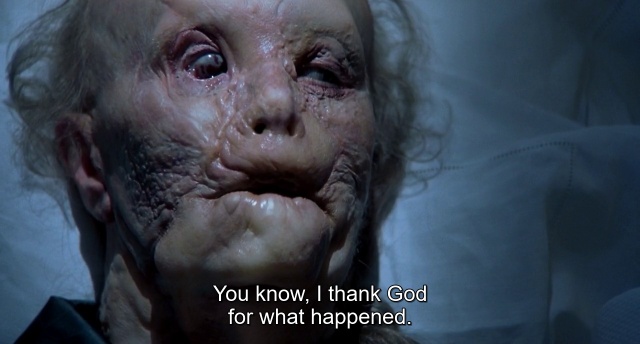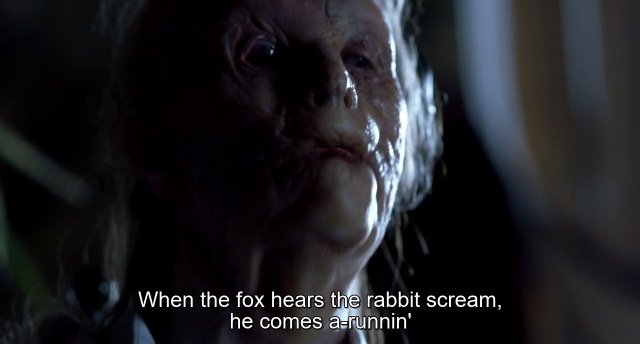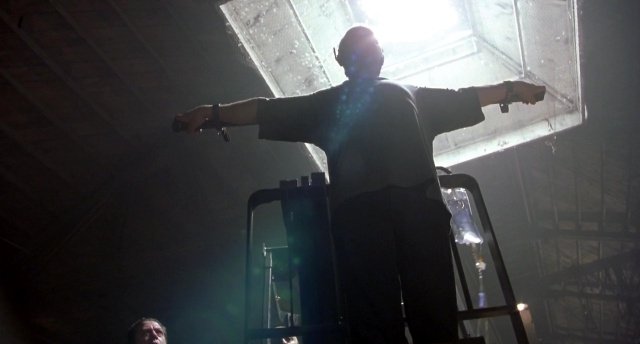It is quite extraordinarily, in retrospect, to realise that this 2001 film was the first Hannibal Lecter film to be about Hannibal Lecter. He was very much a bit player in both Manhunter and Red Dragon (both based on the book Red Dragon) – he was in an asylum and visited occasionally by Will Graham, desperate for a clue as to the identity of the serial killer the FBI was hunting. The movie that made him a household name, The Silence of the Lambs, saw him still in that Baltimore Asylum for the Criminally Insane, but now he was a major figure, even though only on screen for a bit under 16 minutes. But very good minutes they were (he won the Oscar for it, and the film won five in total) and, importantly, we saw him escape, to rejoin us, the viewers, in the breathing world, as we crept, with wide eyes, back to the dark parking lot of the cinema after the credits had rolled.

“I need to come out of retirement and return to public life.”
In Hannibal, he is free, and doing what he loves best – being an expert on Renaissance art and poetry in Florence, drinking fine wines, and occasionally eating people. But, as in the previous movies, and in the TV series, Hannibal takes his sweet time before he actually appears on screen. His image appears at 24 minutes: an archive video of him attacking a nurse who was careless with his ECG (any comments on why he attacks the nurse would be appreciated. It seems out of character for Hannibal: discourteous even).

His voice appears at 28 minutes, and his person at 30. Hannibal never rushes things. Instead, the film starts with Hannibal’s nemeses: Mason Verger, intent on revenge and plotting to capture Hannibal and feed him to his pigs, and of course Clarice Starling, her career in tatters due to a combination of law enforcement ineptitude and toxic masculinity working to bring her down. She is caught on the news shooting a woman with a baby, even though that woman was a drug dealer who was shooting at her.

Her only possible way to reinstate her career will be to work with Verger to capture Hannibal.
This wasn’t an easy film to make – sequels rarely are, particularly when they are following a film that did a lot better than anyone expected. And this film was made ten years after Silence, so there was a huge, pent up demand. There was also the brilliant book from Thomas Harris on which this was based; it had come out two years previously, and many, including the director of Silence, Jonathan Demme, the screenwriter, Ted Tally, and the star, Jodie Foster, considered the plot a bridge too far. All three declined to be involved in the new film. Lucklily, Anthony Hopkins was ready to get back in the saddle, so the film proceeded – without him, it would seem to have been unlikely.
So, sad not to get Demme back to direct, but hey, Dino di Laurentiis found a substitute: the brilliant Ridley Scott (Alien, Blade Runner, Thelma and Louise), who had just finished Gladiator and at first declined the script, as he thought it was another ancient history epic, and didn’t want to have to direct elephants crossing the Alps. Oh, it’s about a cannibal in Florence? OK then. The screenplay was first drafted by Pulitzer Prize winner David Mamet and then written by Steven Zaillian (Schindler’s List). And instead of the incomparable Jodie Foster, he chose, from a list of the greatest actors of the time, Julianne Moore, apparently the recommendation of Hopkins. di Laurentiis said of Jodie Foster’s refusal to take part: “when the Pope dies, they get a new Pope”. So it was off to a rollicking start.
Then there’s the supervillain. In Hannibal movies, there is always a much worse monster for us to hate, giving us licence to like Hannibal that much more. In this case, it is Mason Verger (Gary Oldman), heir to a huge fortune built on the cruel pork trade, a sadist and child molester in his youth.

He is the only surviving victim of Hannibal: instead of killing him, Hannibal got him whacked on psychotropic drugs and suggested that he slice his own face off and feed it to the dogs. In the book, this is explained: Mason had adopted two dogs who were good friends, and put them in a cage with no food, to see if they would turn to cannibalism. Gratuitous cruelty and cannibalism – not what Hannibal is about at all. Hannibal’s cannibalism contains a nugget of justice. As the Asylum orderly Barney tells Clarice:
He told me that whenever feasible, he prefers to eat the rude. Free range rude, he called them.
Incidentally, Barney is portrayed by Frankie Faison (The Wire) who is the only actor to appear in all four Hannibal films up to this one.
Hannibal manages to communicate with Clarice throughout the film, usually by letter or phone call, explaining his point of view and questioning why she continues to serve her corrupt and venal masters.
Tell me Clarice, would you want to harm those who have forced you to consider it though? It’s perfectly OK to feel this. It’s perfectly au naturel to want to taste the enemy. It just feels so good.

The camera lingers lovingly on Mason’s disfigurements: according to the DVD, Oldman spent six hours each day in makeup to make him so lovable. Hopkins, on the other hand, did not bother with makeup for this movie, allowing his advancing years and natural pallor to tell the story of the years since his escape.

With Hannibal, there is always the question of who is the cannibal. In Red Dragon, was it Hannibal in his cell or Dolarhyde collecting movies of women he had killed and raped? In Silence, was it the same Hannibal in the same cell, or Jame Gumb, killing and skinning women to make a vest with tits? In this one, is it the Renaissance scholar Hannibal seeking a job as curator of the Capponi library or Inspector Pazzi (Giancarlo Giannini), threatening a local pickpocket into ambushing Hannibal, hoping to sell Hannibal to Verger to be fed to his pigs? The pickpocket loses his femoral artery to a small knife that Hannibal keeps in his sleeve. He dies, but Pazzi gets the fingerprint he needs for the deal to go ahead and in a scene full of Catholic symbolism, washes his bloody hands in the fountain of Il Porcellino, a porcine reference to the greed of Judas and the cowardice of Pontius Pilate, as well as a foretaste of the pigs who have been bred to eat Hannibal. Verger and his thugs get the pigs flown to the US and primed to eat humans (pigs usually prefer not to). Pazzi later gets from Hannibal the same treatment his treasonous ancestor received in Florence 500 years earlier – hanging from the window with his bowels protruding. But not until Hannibal has offered the line of the movie:


Hannibal has met Pazzi’s wife, Allegra (Francesca Neri), at the sublime opera of Dante’s sonnet A ciascun’alma presa from Vita Nuova, which Hannibal and Allegra recite to each other meaningfully, all about Beatrice eating Dante’s heart, and clearly referencing Hannibal’s growing obsession with Clarice.

In a scene that reveals both Pazzi’s desperation to make Allegra happy, including risking his career and life to capture Hannibal, and Hannibal’s own burning love for Clarice, she asks him:
Allegra: Dr Fell, do you believe a man could become so obsessed with a woman from a single encounter?
Hannibal: Could he daily feel a stab of hunger for her and find nourishment in the very sight of her? I think so. But would she then see through the bars of his plight and ache for him?
Dante and Beatrice were nine years old when his obsession with her started. Hannibal’s obsession with Clarice started at a more mature age, but burns just as brightly.
The music, Vide Cor Meum, is by Hans Zimmer (Lion King, Gladiator, the Dark Knight trilogy and heaps more) and is so beautiful that it is used again in the TV series Hannibal, in the season finales of both the first two seasons. As she leaves with Pazzi, another couple brush past saying “let’s get something to eat!” Hannibal mutters to himself, and to us, “why not?”
Verger understands that the way to trap Hannibal is by threatening Clarice, and pays Paul Krendler (Ray Liotto), the man who has conspired to destroy Clarice’s career since she first rebuffed his advances, to fabricate evidence of collusion with Hannibal.

She is suspended from the FBI. Hannibal goes shopping for fine furniture, and burglaring for medical equipment. He breaks into Clarice’s apartment in DC, where she has drunk herself to sleep, and leaves a collage of her face on a fashion shoot in a magazine. The game is afoot. He leads her to Union Station where he engages her in a discussion of her life, her future, and why the forces of the law, the law she loves and respects, have totally betrayed her.
Why are you so resented? You serve the idea of order, Clarice. They don’t. You believe in the oath you took. They don’t. You feel it is your duty to protect the sheep. They don’t.
As he leaves, Verger’s Sardinian hit-men hit him with a tranquiliser dart and drive him off. Now who will save whom?

Hannibal is strapped to a forklift in a crucifixion position, his feet are to be fed to the pigs, then he is to be kept alive for several hours until the rest of him is given to them. She cuts him loose, leading to one of the funniest exchanges in the film.

Clarice can deal with most of these thugs, but is shot while rescuing Hannibal, who picks her up and walks through the hogs. They leave him alone – since they cannot smell fear on him. He arranges for Verger’s helper to push the furious billionaire into the pig pen. Dinner is served.

Krendler returns to his lakehouse, but Hannibal is already there. So is Clarice; Hannibal has removed the bullet and she is sedated. She wakes dressed in full evening gown and high heels and staggers downstairs where, in the most famous scene of the film, Hannibal has sawn Krendler’s cranium off, and is preparing to serve his brain. Of course, the brain has no pain receptors on its surface, so Krendler is awake and joins the meal.

Most of this is fairly true to the book. Only the ending was changed, apparently to appeal to those whose morality could stand seeing a man eat his own brains, but not to seeing Starling, so long an honest cop, go over to Lecter’s side – the side of cynicism about authority and enjoyment of the finer things of life. Instead, she rebuffs him and with her remaining strength tries to stop the dinner, and then the escape. She hancuffs the two of them together, Hannibal goes to bite her, then to cut off her hand, but it is he that leaves minus one. That’s love.


But then, there is the single tear – does she regret the opportunity to dance with the devil?

I admit to preferring the story the way the author wrote it in the book. I think Hannibal would have too. Read the book and you will see that is the perfect denouement to the Hannibal saga. I think they compromised on the end to avoid controversy (although they did get away with feeding Krendler his own brain, so they weren’t totally devoid of courage).
I suspect that the idea of amputation of his hand came from Sir Anthony Hopkins, who had starred in Shakespeare’s Titus only two years earlier, in which he cuts off his hand, and his daughter suffers a worse fate involving both hands and her tongue. [I nearly said Hopkins had a hand in the decision, but I restrained myself].
Titus is also a cannibal movie, by the way. You can read my blog about it at Titus.
Why does Hannibal eat people? Clarice speculates on this earlier in the film, while she is still on the case, as Krendler asks her what she’s doing sitting in the dark.
Thinking about cannibalism. Aren’t you curious why he dines on his victims? To show his contempt for those who exasperate him. Or sometimes to perform a public service. In the case of the flutist, Benjamin Raspail, he did it to improve the sound of the Baltimore Philharmonic Orchestra, serving the not so talented flute player’s sweetbreads to the Board with a nice Montrachet at $700 per bottle.
Yes, Clarice, quite right. But also, like any cuisine, it’s a habit, or a preference. Hannibal simply cannot see any reason not to eat people, particularly rude ones. In the final scene, he offers to give it all up for her:





BTW: note the books on Krendler’s fridge: Southern Cooking and Vegetarian Times. Our ethical choices: what we consider right, or what we consider delicious. Hannibal, unlike everyone else, makes his choices without hesitating. He considers them the same thing.

A very astute review. The analogy to Dante Beatrice was surprising and disturbing. Thanks.
LikeLiked by 1 person
Thank you! I hadn’t known at the time I wrote this that Dali did a series of woodblocks based on The Divine Comedy. Would have been a great opening image.
LikeLiked by 1 person
Pingback: “He is the devil. He is smoke.” HANNIBAL Season 2 Episode 05 “Mukōzuke” (Fuller, 2014) – The Cannibal Guy
Pingback: Hannibal in your head – HANNIBAL Season 2 Episode 7 (Fuller, 2014) – The Cannibal Guy
Pingback: “Hiding and revealing identity” – HANNIBAL Season 2, Episode 12 “Tome-wan”, (Fuller, 2014) – The Cannibal Guy
Pingback: Copycat Killers 1.08 HANNIBAL: “A real life Hannibal Lecter comes to light” – The Cannibal Guy
Pingback: Cartman’s Cannibalism: SOUTH PARK S5E4 “Scott Tenorman Must Die” (Parker & Stone, 2001) – The Cannibal Guy
Pingback: “In the Belly of the Beast” HANNIBAL Season 3 Episode 5 “Contorno” – The Cannibal Guy
Pingback: “What’s for dinner?” HANNIBAL Season 3 Episode 6, “Dolce” (Fuller, 2015) – The Cannibal Guy
Pingback: Don’t play with your food… HANNIBAL Season 3 Episode 7, “Digestivo” – The Cannibal Guy
Pingback: “Is Hannibal in love with me?” HANNIBAL 3:12 “The Number of the Beast Is 666” – The Cannibal Guy
Pingback: HANNIBAL: a complete listing of my Hannibal film and TV blogs – The Cannibal Guy
Pingback: The Silence of Hannibal: CLARICE episode 1 (CBS 2021) – The Cannibal Guy
Pingback: “It’s primitive as can be”: GILLIGAN’S ISLAND (1964-67) – The Cannibal Guy
Pingback: “Drowning in a river of blood”, SON (Ivan Kavanagh, 2021) – The Cannibal Guy
Pingback: “You are what you eat” – EAT A SWEDE, 2021 – The Cannibal Guy
Pingback: Love and cannibalism: BONES AND ALL (Luca Guadagnino, 2022) – The Cannibal Guy